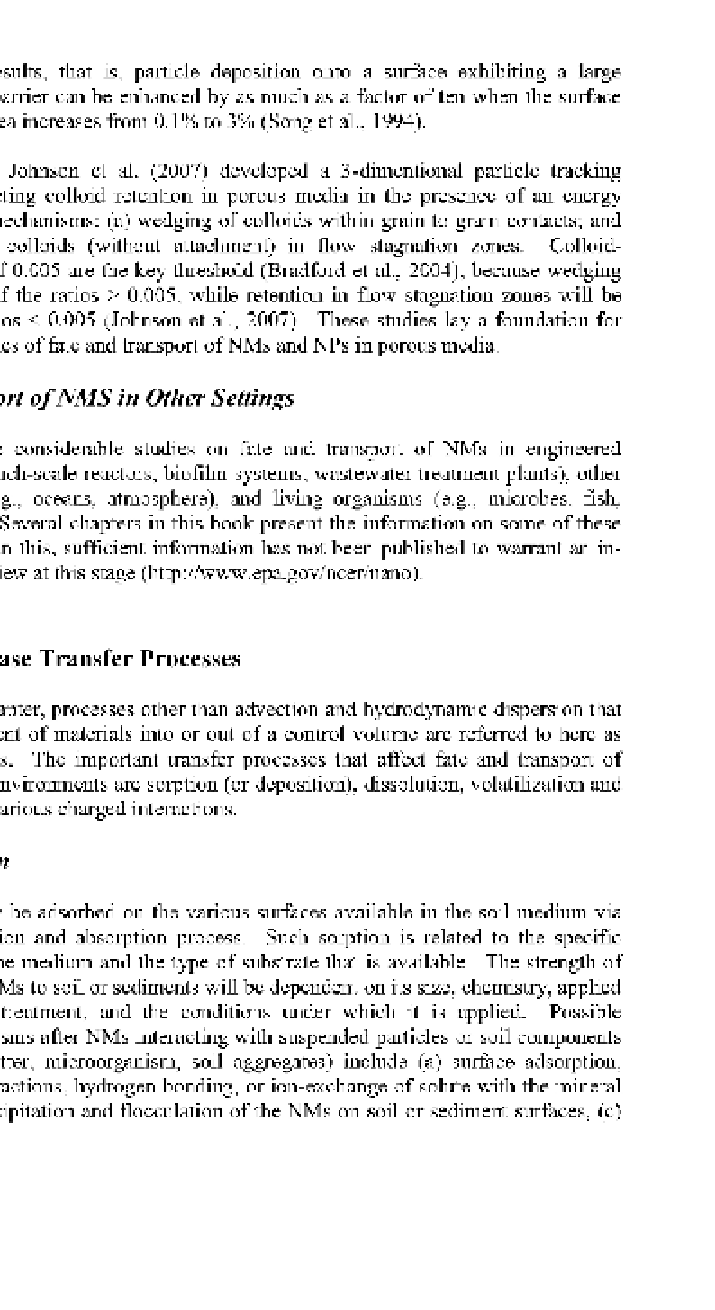Environmental Engineering Reference
In-Depth Information
with previous results, that is, particle deposition onto a surface exhibiting a large
primary energy barrier can be enhanced by as much as a factor of ten when the surface
heterogeneous area increases from 0.1% to 3% (Song et al., 1994).
Recently, Johnson et al. (2007) developed a 3-dimentional particle tracking
model for predicting colloid retention in porous media in the presence of an energy
barrier via two mechanisms: (a) wedging of colloids within grain to grain contacts; and
(b) retention of colloids (without attachment) in flow stagnation zones. Colloid-
collector ratios of 0.005 are the key threshold (Bradford et al., 2004), because wedging
will be favored if the ratios > 0.005, while retention in flow stagnation zones will be
prevail if the ratios < 0.005 (Johnson et al., 2007). These studies lay a foundation for
mechanistic studies of fate and transport of NMs and NPs in porous media.
75.2.3
Transport of NMS in Other Settings
There are considerable studies on fate and transport of NMs in engineered
systems (e.g., bench-scale reactors, biofilm systems, wastewater treatment plants), other
environments (e.g., oceans, atmosphere), and living organisms (e.g., microbes, fish,
human beings). Several chapters in this topic present the information on some of these
studies; other than this, sufficient information has not been published to warrant an in-
depth critical review at this stage (
http://www.epa.gov/ncer/nano).
15.3 Interphase Transfer Processes
In this chapter, processes other than advection and hydrodynamic dispersion that
result in movement of materials into or out of a control volume are referred to here as
transfer processes. The important transfer processes that affect fate and transport of
NMs in aquatic environments are sorption (or deposition), dissolution, volatilization and
absorption, and various charged interactions.
15.3.1 Sorption
NMs may be adsorbed on the various surfaces available in the soil medium via
both the adsorption and absorption process. Such sorption is related to the specific
surface area of the medium and the type of substrate that is available. The strength of
the sorption of NMs to soil or sediments will be dependent on its size, chemistry, applied
particle surface treatment, and the conditions under which it is applied. Possible
sorption mechanisms after NMs interacting with suspended particles or soil components
(e.g. organic matter, microorganism, soil aggregates) include (a) surface adsorption,
electrostatic interactions, hydrogen bonding, or ion-exchange of solute with the mineral
surfaces, (b) precipitation and flocculation of the NMs on soil or sediment surfaces, (c)

Search WWH ::

Custom Search